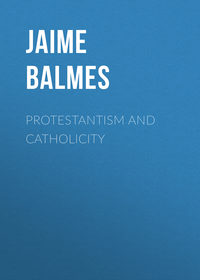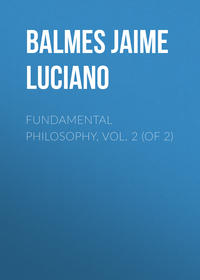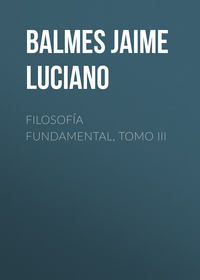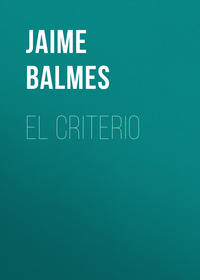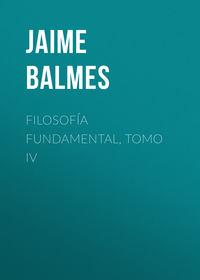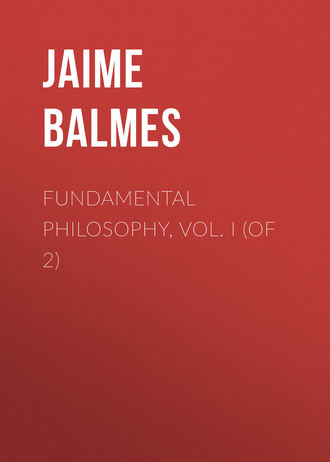 полная версия
полная версияFundamental Philosophy, Vol. I (of 2)
Two circumferences having the same radius are equal. Here we seem to treat solely of equality, since there are two distinct objects, the two circumferences, which may be traced on paper or represented in the imagination; yet not even in this case is the distinction true, it is only apparent, for here, as in algebraical and arithmetical equations, there is distinction and even diversity in form with identity at bottom. The principal argument, on which the distinction is founded, may be combatted by observing that the circumferences which may be traced or represented, are only forms of the idea, not the idea itself. Whether traced or represented they have a determinate size and a certain position on the planes seen or imagined; in the idea, and in the proposition containing it, there is nothing of this; we abstract all size, all position, and speak in a general and absolute sense. True, the representations may be infinite either externally or in the imagination; but this, so far from proving them identical, shows their diversity, since the idea is one and they are infinite; the idea is constant, they are variable; the idea is independent of them, they are dependent on the idea, and have the character and denomination of circumferences, inasmuch as they approach it by representing what it contains.
What, then, is expressed in the proposition: two circumferences, having the same radius, are equal? The fundamental idea is, that the value of the circumference depends upon the radius, and the proposition here enunciated is simply an application of this property to the case of the equality of radii. The circumferences, then, conceived by us as distinct, are only examples which we inwardly consider in order to render the truth of the application apparent; but in what is purely intellectual, we find only the decomposition of the idea of circumference, or its relation to the radius applied to the case of equality. Then there are not two circumferences in the purely ideal order, but one only, whose properties we know under different conceptions, and express in various ways.
If in all judgments there is affirmation of identity, or non-identity, and all our cognitions either begin or end in a judgment, it would seem that they all ought to be reduced to a simple perception of identity. The general formula of our cognitions will then be: A is A, or, a thing is itself. This result strikes one as an extravagant paradox, and is so, or not, according to the sense in which it is understood; but if rightly explained, it may be admitted as a truth, and a very simple one. From what has been said in the preceding paragraphs, the meaning of this opinion may be discerned: but the importance of the present matter requires still further explanation.
CHAPTER XXVII.
CONTINUATION OF THE SAME SUBJECT
269. It is even ridiculous to say that the cognitions of the sublimest philosophers may be reduced to this equation: A is A. This, absolutely speaking, is not only false, but contrary to common sense; but it is neither contrary to common sense nor false to say that all cognitions of mathematicians are perceptions of identity, which, presented under different conceptions, undergoes infinite variations of form, and so fecundates the intellect and constitutes science. For the sake of greater clearness we will take an example, and follow one idea through all its transformations.
270. The equation circle = circle (1) is very true, but not very lucid, since it serves no purpose, because there is identity not only of ideas but likewise of conceptions and expression. To have a true progress in science we must not only change the expression, but also vary in some way the conception under which the identical thing is presented. Thus, if we abbreviate the above equation in this form: C = circle (2), we make no progress, unless with respect to the purely material expression. The only possible advantage of this is to assist the memory, as instead of expressing the circle by a word, we express it by its initial letter, C. Why is this? Because the variety is in the expression, not in the conception. If, instead of considering the identity in all its simplicity in both members of the equation, we give the value of the circle with reference to the circumference, we shall have C = circumference × 1/2 R (3), that is, the value of the circle is equal to the circumference multiplied by one-half the radius. In the equation (3) there is identity as in (1) and (2), because it is affirmed in it that the value expressed by C is the same as that expressed by circumference × 1/2 R; just as in the other two it is expressed that the value of the circle is the value of the circle. But is this equation different from the other two? It is very different. What is the difference? The first two simply express the identity conceived under the same point of view; the circle expressed in the second member excites no idea not already excited by the first; but in the last, the second member expresses the same circle indeed, but in its relations with the circumference and radius; and, consequently, besides containing a sort of analysis of the circle, it records the analysis previously made of the idea of the circumference in relation to the idea of radius. The difference is not, then, solely in the material expression, but in the variety of conceptions under which the same thing is presented.
Calling the value of the relation of the circumference with the diameter N, and the circle C, the equation becomes: C = NR2 (4). Here, also, there is identity of value; but we discover a notable progress in the expression of the second member, in which the value of the circle is given, freed from its relations with the value of the circumference, and dependent solely on a numerical value, N, and a right line, which is the radius. Without losing the identity, and only by a succession of perceptions of identity, we have advanced in science, and starting from so sterile a proposition as circle = circle, we have obtained another, by means of which we may at once determine the value of any circle from its radius.
Leaving elemental geometry, and considering the circle as a curve referred to two axes, with respect to which its points are determined, we shall have Z = 2Bx-x2(5); Z expressing the value of the ordinate; B the constant part of the axis of abscissas; and x the abscissa corresponding to Z. We have here a still more notable progress of ideas: in both members we now express the value, not of the circle, but of lines, by which we may determine all points of the curve; and we easily conceive that this curve, which was contained in the figure whose properties we determined in elemental geometry, may be conceived under such a form as belongs to a genus of curves, whereof it constitutes a species by the particular relations of the quantities 2x and B; thus modifying the expression by adding a new quantity, combined in this or that manner, we may obtain a curve of another species. If, therefore, we would determine the value of the surface contained in this circle, we may consider it, not solely with respect to the radius, but to the areas comprised between the various perpendiculars the extremities of which determine points of the curve and are called ordinates. It results from this, that the same value of the circle may be determined under various conceptions, although this value is at all times identical; the transition from one conception to another is the succession of the perceptions of identity presented under different forms.
Let us now consider the value of the circle dependent on the radius: this will give us C = function x (6). This equation enables us to conceive the circle under the general idea of a function of its radius, or of x, and consequently authorizes us to subject it to all the laws to which a function is subject, and leads us to the properties of their differentials, limits, and relations. By this equation we enter into infinitesimal calculus, the expressions of which present identity under a form which records a series of conceptions of long and profound analysis. Thus, expressing the differential of the circle by dc, and its integral by S. dc, we shall have C = S. dc, (7), an equation in which are expressed the same values as in circle = circle, but with this difference, that the equation (7) records immense analytical labors: it results from a long succession of conceptions of integral calculus, of differentials, and limits of the differentials of the functions, of the application of algebra to geometry, and of a multitude of elementary geometrical notions, algebraical rules and combinations, and of whatever else was needed to arrive at this result. Therefore, when we find the integral of the differential, and obtain by integration the value of the circle, it would clearly be most extravagant to affirm that the integral equation is nothing more than the equation circle = circle; but it is not so to say that at bottom there is identity, and that the diversity of expression to which we have come, is the result of a succession of perceptions of the same identity presented under different aspects. Supposing the conceptions, through which it has been necessary to pass, to be A, B, C, D, E, M, the law of their scientific connection may be thus expressed: A = B, B = C, C = D, D = E, E = M; therefore A = M.
271. What we have just explained cannot be well understood unless we recall some characteristics of our intellect, in which is found the reason of so great anomalies. Our intellect is so weak as to perceive things only successively: only after much study does it see what is contained in the clearest ideas. Hence a necessity, to which corresponds with admirable harmony a faculty that satisfies it: the necessity is of conceiving under various, and different, as well as distinct, forms, even the simplest things: the faculty is that of decomposing the conception into many parts, and multiplying in the order of ideas what in that of reality is only one. This faculty of decomposition would be useless were not the intellect, in passing through the succession of conceptions, to find means of connecting and retaining them: otherwise it would continually lose the fruit of its labors; it would slip from its hands as fast as it grasped it. Happily it has this means in signs either written, spoken, or thought; those mysterious expressions which at times not only designate an idea, but also are the compendium of the labors of a whole life, and perhaps of a long series of ages. When the sign is presented to us, we do not see certainly and with full clearness all that it expresses, nor why the expression is legitimate; but we know confusedly the meaning therein contained; we know that in case of necessity, it is enough for us to follow the thread of the perceptions through which we have passed, thus going back even to the simplest elements of science. In making calculations, the most eminent mathematician does not clearly see the meaning of the expressions he uses, except as they relate to the object before him; but he is certain that they do not deceive him, that the rules by which he is guided are sure; because he knows that at another time he established them by incontestible demonstrations. The progress of a science may be compared to a series of posts on which the distances of a road are marked: he who marked the numbers on the posts uses them without necessity of recalling the operations which led him to mark the quantity before him; he is satisfied with knowing that the operations were well made, and that he wrote the result correctly.
272. The proof of this necessity of decomposition, besides being fully established by the above example, is found in the elements of all instruction, where, under a form of demonstration, it is necessary to explain propositions which express simply the definitions or axioms that have been before established. For example: we find in the elementary works on geometry this theorem: all the diameters of a circle are equal; and we must, if we would have beginners understand it, give a demonstrative form to that which neither is nor can be any thing more than an explanation, and is almost a repetition of the idea of the circle. When we describe a circle, we fix a point around which we revolve a line called the radius; since then the diameter is nothing more than the sum of two radii continued in the same right line, the mere enunciation of the theorem would seem sufficient to show that it is evidently contained in the idea of the circle, and is as a sort of repetition of the postulate, on which the construction of the curve is founded: still it is not so, and it must be explained as if it were a proof; we must show the diameter to be equal to two radii, these radii to be equal, and at times repeat that this is supposed in its construction: in a word, it is necessary to employ many conceptions to show a truth, which ought to have been known by the simple intuition of one alone, as is the case when the geometrical powers of the intellect have acquired a certain strength and robustness.
273. We may now appreciate at its just value, the opinion of Dugald Stewart, who, in his Elements of the Philosophy of the Human Mind, says: "It may be fairly questioned, too, whether it can, with strict correctness, be said of the simple arithmetical equation, 2 plus 2 = 4, that it may be represented by the formula A = A. The one is a proposition asserting the equivalence of two different expressions; to ascertain which equivalence may, in numberless cases, be an object of the highest importance. The other is altogether unmeaning and nugatory, and cannot, by any possible supposition, admit of the slightest application of a practical nature. What opinion then shall we form of the proposition A = A, when considered as the representative of such a formula as the binomial theorem of Sir Isaac Newton? When applied to the equation 2 plus 2 = 4, (which in its extreme simplicity and familiarity is apt to be regarded in the light of an axiom:) the paradox does not appear to be so manifestly extravagant; but, in the other case, it seems quite impossible to annex to it any meaning whatever."22 This philosopher does not observe that the pretended extravagance arises from his wrong interpretation of his adversaries' opinion. No one ever thought of denying the importance of the discoveries which prove different expressions equivalent: no one doubts that Newton's formula of the binomial is a great advance upon the formula A = A: but the question consists not in this, but in seeing whether Newton's formula of the binomial is any thing more than the expression of identical things; and whether even the merit of the expression is or is not the fruit of a series of perceptions of identity. Were the question presented under Dugald Stewart's point of view, it would be unworthy of discussion: for philosophy should not dispute upon things that are ridiculous as well as absurd.
CHAPTER XXVIII.
CONTINUATION OF THE SAME SUBJECT
274. We will now explain how the doctrine of identity is applied in general to all reasoning, whether upon mathematical objects or not: with this view we will examine some of the dialectical forms in which the art of reasoning is taught.
Every A is B; M is A: therefore M is B. In the major of this syllogism we find the identity of every A with B; and in the minor, the identity of M with B. In each of these propositions there is affirmation, and, consequently, perception of identity. Let us now see what takes place in the connection which constitutes the force of the argument.
Why do we say that M is B? Because M is A, and every A is B. M is one of the As, expressed in the words every A; therefore, when we say, M is A, we say only what we had before said by every A. What difference, then, is there? There is this difference, that in the expression every A, no attention is paid to one of A's contents, M, of which we had nevertheless affirmed that it was B, in affirming that every A is B. If, in the expression every A, we have distinctly seen M, the syllogism would not have been necessary, because, in saying every A is B, we had already understood that M is B.
This observation is so true and exact, that in treating of very clear relations we suppress the syllogism, and replace it with the enthymema, which is, it is true, an abbreviation of the syllogism; but we must see in this abbreviation besides a saving of words, a saving of conceptions, for the intellect sees one intuitively in the other, without necessity of decomposition. He is a man, therefore he is rational; we omit the major, and do not even think of it, for we intuitively see, in the idea of man, and its application to an individual, the idea of rational without any gradation of ideas or succession of conceptions.
Let us suppose that we have to demonstrate that the perimeter of a polygon inscribed in a circle is less than the circumference, and that we make the following syllogism: The sum of all the right lines inscribed in their respective curves is less than the sum of those curves; but the perimeter of the polygon is the sum of the right lines, and the circumference is the sum of the arcs or curves; therefore the inscribed perimeter is less than the circumference. We now ask, will any one who knows that the sum of the right lines is less than the sum of the curves, fail to see with equal facility that the perimeter is less than the circumscribed circumference, provided he understands the meaning of the words? It is evident that he will not. What necessity, then, of repeating the general principle? Is it to add any thing to the particular conception? Certainly not; because nothing can be clearer than the following propositions: the perimeter of the polygon is a sum of right lines; the circumference is a sum of arcs or curves; what the general principle does, is to call attention to a phase of the particular conception, so that what otherwise could not be seen in it may be seen on reflection. The certainty of the conclusion does not depend on the general principle; because, from thinking on the relations of greater and less only with respect to the right lines of the perimeter and the arcs, the sum of which forms the circumference, any one would have inferred the same thing.
This example also tends to prove that the enthymema is not a mere abbreviation of words; and it shows why we employ it in reasoning upon matters familiar to the understanding. In any one of the conceptions we see all that is necessary for the consequence; and, therefore, one premise suffices, as in it the other is included rather than understood. A beginner may say: the arc is greater than the chord, because the curve is greater than the right line; but when familiarized with geometrical ideas, he will simply say, the arc is greater than the chord; he will see the idea of the curve in that of the arc, and the idea of the right line in that of the chord, without need of decomposition. If the arc is greater than its chord, this is not because every curve is greater than the corresponding right line. Did the abstract idea of curve not exist, and were this particular arc of a circle the only curve thought of; did the abstract idea of right line not exist, and were this particular chord the only right line thought of, it would still, as at present, be true that the arc is greater than the chord.
275. When treating of the necessary relations of things, the general principles, the middle terms, and all the auxiliaries to reasoning furnished by logic, are only inventions of art to make us reflect upon the conception of the thing, and see in it what otherwise we should not see. Hence our judgments on necessary objects are in some sense analytical; and Kant equivocates, when he says there are synthetic judgments not dependent on experience. Without experience we have only the conception of the thing. We do not pretend that all propositions express such a relation between the subject and the predicate, that the conception of the former will always give that of the latter; but we do hold, that the reason of this insufficiency is the incompleteness of the conception, either in itself, or in relation to our comprehension. But if we suppose the conception complete in itself, and a due capacity in our intellect to understand whatever it contains, we shall find in the conception all that can be the object of science.
276. An example from mathematics will make this clearer. Large works on geometry are filled with explanations, demonstrations, and applications of the properties of the triangle. The conceptions of right lines, and the angles formed by them, enter into the conception of the triangle. We ask, can all the explanations and demonstrations of the properties of triangles in general ever go beyond the ideas of right lines and angles? No. For the new elements introduced would be foreign to the triangle, and would consequently change its nature. Necessary relations neither admit of more nor of less, neither additions nor subtractions of any sort; what is, is, and nothing more. In passing from the triangle in general to its different species, such as equilateral, isosceles, right angled, scalene, it is to be observed that the demonstration must rigorously attend to what is contained in the general conception, modified by the determining properties of the species, that is, the equality of the three sides, of two, the inequality of all, the supposition of a right angle, and others.
277. What we are now explaining is clearly seen in the application of algebra to geometry. A curve is expressed by a formula containing the conception of the curve, or its essence. The geometrician, to demonstrate the properties of the curve, does not need to go out of this formula; it is a touch-stone in his hand, and he finds in it all that he wants. He inscribes triangles, or other figures in the curve, draws right lines from it to points without, but never goes out of the conception expressed in the formula; he decomposes it, and finds in it what before he had not discovered.
In this equation z2 = (e2/E2)(2Ex-x2), we find the expression of the relations which constitute the ellipse; E expresses the greater semi-axis, e the lesser, z the ordinates, and x the abscissas. With this equation variously developed and transformed, the properties of the curve are determined; it shows, with the help of constructions, that the new property is contained in the conception, and to find it, we have only to analyze it.
If we suppose an intelligence capable of conceiving the essence of the curve, by an immediate intuition of the law governing the inflection of points, without the necessity of referring it to any line, whether one axis instead of two suffices, or in any other manner not even imaginable by us; this intelligence will not need to follow all the evolutions which we have made in demonstrating the properties of the curve; for it will perceive them to be clearly contained in the very conception of the curve. This supposition is not arbitrary; we see it realized every day, though on a smaller scale. An ordinary geometrician conceives a curve as also does Pascal; but while Pascal at a glance sees the most recondite properties of the curve in this conception, an ordinary geometrician sees only after long study its most common properties. Kant made no account of this doctrine, and therefore could not solve the problem of pure synthetic judgments: had he examined the subject more profoundly he would have seen that, strictly speaking, there are no such judgments; and instead of wearing out his genius in attempting to solve an insolvable problem, he would have abstained from raising it.(26)
CHAPTER XXIX.
ARE THERE TRUE SYNTHETIC JUDGMENTS A PRIORI IN THE SENSE OF KANT?
278. The great importance attributed by the German philosopher to his imaginary discovery, requires us to examine it at length. This importance may be estimated from what he himself says: "If any of the ancients had only had the idea of proposing the present question, it would have been a mighty barrier against all the systems of pure reason down to our days, and would have saved many vain attempts which were blindly made without knowing what was treated of."23 This passage is quite modest and naturally excites our curiosity to know what is the problem which needed only to be proposed in order to avoid all the aberrations of pure reason.
Here are his words: "All empirical judgments, as such, are synthetic. For it would be absurd to ground an analytic judgment on experience, since I am not obliged to go out of the conception itself in order to form the judgment, and therefore can have no need of the testimony of experience. That a body is extended, is a proposition which stands firm a priori. It is no empirical judgment; for, prior to experience, I have all the conditions of forming it in the conception of body, from which I deduce the predicate, extension, according to the principle of contradiction, by which I at once become conscious of its necessity, which I could not learn from experience. But, on the other hand, I do not include, in the primitive conception of body in general, the predicate, heaviness; yet this conception of body in general indicates, through experience of a part of it, an object of experience, to which I may add from experience other parts also belonging to it. I can attain to the conception of body beforehand, analytically, through its characteristics extension, impenetrability, form, etc., all of which are included in the primary conception of body. But I now extend my cognition, and, as I recur to experience, from which I have obtained the conception of body in general, I find along with these characteristics the conception of heaviness. I therefore add this, as a predicate, to the conception of body. The possibility of this synthesis therefore rests on experience; for both conceptions, although one does not contain the other, yet belong as parts to a whole, that is to say, to experience, which is itself a union of synthetic, though contingent intuitions. But in the case of synthetic judgments a priori we have not this assistance. Here we have not the advantage of returning and supporting ourselves on experience. If I must go out of the conception A in order to find another conception B, which is to be joined to it, on what am I to rely? and by what means does the synthesis become possible?"24




